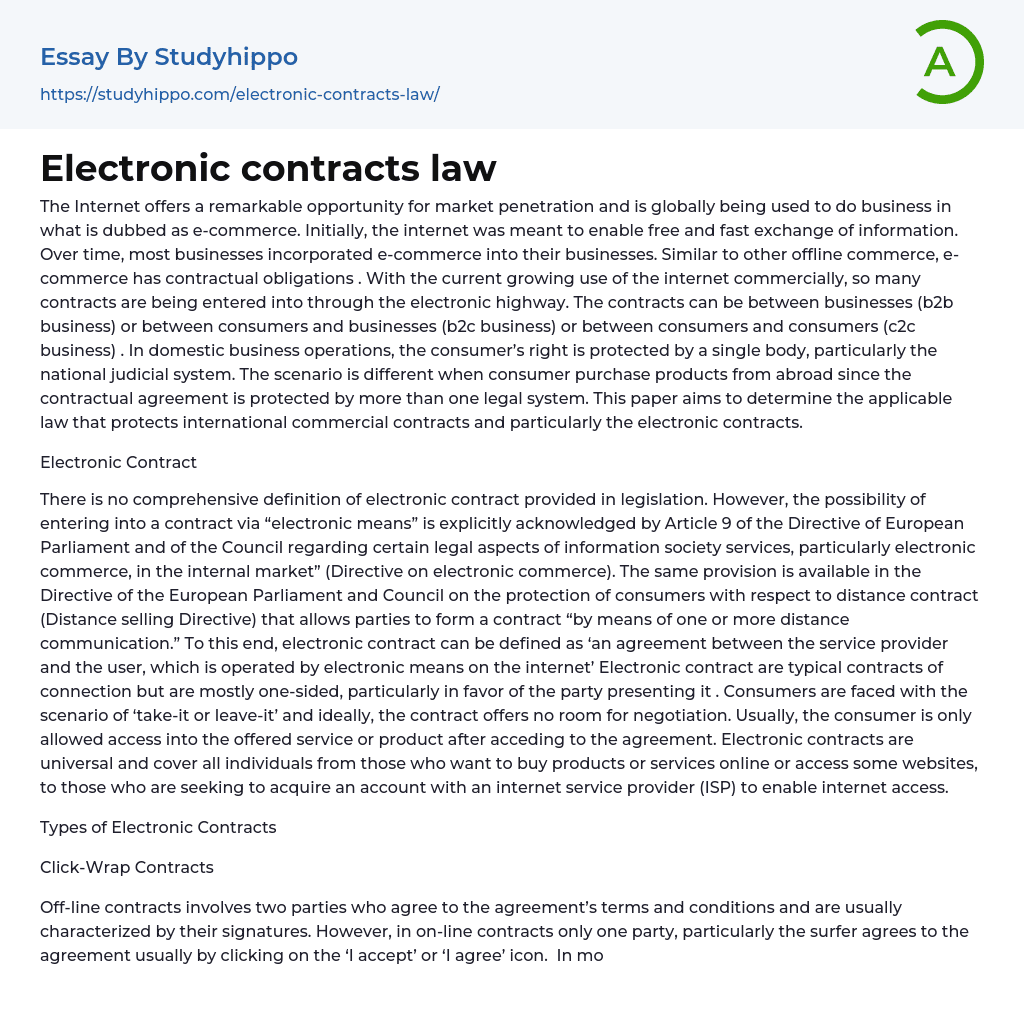The Internet offers a distinctive opportunity for global market expansion and is widely used for conducting e-commerce. Originally, it was created to enable the efficient and unrestricted exchange of information. Over time, businesses have incorporated e-commerce into their operations, which involves contractual obligations similar to those in traditional commerce.
The internet has caused a rise in online contracts for commercial purposes. These contracts can involve businesses (B2B), businesses and consumers (B2C), or consumers and consumers (C2C). In domestic transactions, consumer rights are protected by the national judicial system. However, when consumers buy products from foreign countries, their contractual agreement is governed by multiple legal systems. This paper seeks to identify the applicable laws that regulate international commercial contracts created electronically.
Explanation of Electronic Contract
No complete legislative definition exists for an electronic contract.
...Both Article 9 of the Directive on electronic commerce and the Distance selling Directive acknowledge the potential for conducting contracts through electronic means. An electronic contract refers to an online agreement between a service provider and a user. However, these contracts are typically one-sided and heavily favor the party presenting them. Consumers often lack bargaining power and must either accept the offered terms or be unable to access the service or product. These electronic contracts apply to all individuals, ranging from online purchasers to those seeking internet access with an ISP.
Various Types of Electronic Contracts
Click-Wrap Contracts
Offline contracts usually involve two parties who give their consent to the terms and conditions of the agreement, often indicated by their signatures.
There is a distinction between paper and electronic agreements when it comes to online contracts. In paper contracts, negotiations on terms usually happen before signing
while in electronic contracts, consumers have no bargaining power and must agree by clicking a specific icon or be denied access to the desired website, service, or product. This is because e-commerce logistics prevent effective negotiation with consumers. Clip-wrap contracts serve various purposes such as granting webpage access, enabling purchases, facilitating software downloads, establishing terms of use and privacy policies for websites, and imposing restrictions on downloaded material usage. Violating these terms makes legal action against users easier.
Browse-Wrap Agreements
Browse-wrap agreements differ from click-wrap agreements as they do not require active consent from users. Instead, acceptance occurs through browsing or engaging in any other activity on the website without specifically reviewing the electronic contract.
Typically, browse-wrap agreements are displayed as a link at the bottom of a webpage containing the contract's terms and conditions. Users cannot review the contract before accessing the page.
Email-Based Contracts
Courts have recently recognized emails as a potential medium for forming contracts. Many scholars consider email to be an instantaneous form of communication where acceptance can occur. The contract is considered formed upon receipt, not when it is sent. For an email to be a binding agreement, it must meet the basic requirements of offer and acceptance. Furthermore, it must be clear to the courts that both parties intended to enter into and abide by a contract based on their email exchanges, external conversations, and surrounding circumstances.
The role of international organizations in electronic contracting is significant. Within the United Nations Structure, the UN Commission on International Trade Law (UNCITRAL) plays a key role by aiming to unify and harmonize international trade laws. UNCITRAL's objective is to create a legal framework for e-commerce that member
states can adopt for consistency. Since 1992, UNCITRAL has worked towards this goal and has made important contributions in addressing legal issues related to electronic authentication and signature methods in 2009. They have also developed instruments such as the United Nations Convention on the Use of Electronic Communications in International Contracts (2005), the UNCITRAL Model Law on Electronic Signature with Guide to Enactment (2001), and the UNCITRAL Model Law on Electronic Commerce (1996). These instruments promote the use of electronic communication.
Another organization, specifically the International Chamber of Commerce (ICC), focuses on facilitating international trade through its Commission on Commercial Law and Practice (CLP). The ICC aims to promote standardized regulatory and self-regulatory frameworks for business-to-business transactions.
The ICC has established task forces focused on e-commerce and e-contracting laws and jurisdiction.
European Commission (EC)
Both the Council of the European Union and the European Parliament have approved directives that aim to impact electronic contracting in the European Union. In 2000, the Electronic Commerce Directive was introduced to establish guidelines for electronic commerce in the Internal Market. Its objective is to provide legal certainty for consumers and businesses while ensuring proper functioning of e-commerce within the Internal Market. The directive also sets rules for online services in the EU and certifies compliance with specific criteria, establishing a foundation for cross-border online services due to its technological neutrality.
- Email essays
- Hypertext Transfer Protocol essays
- Marshall Mcluhan essays
- Virtual Learning Environment essays
- Web Search essays
- Etiquette essays
- Mainstream essays
- Vodafone essays
- Web Search Engine essays
- Agreement essays
- Business Law essays
- Common Law essays
- Community Policing essays
- Constitution essays
- Consumer Protection essays
- Contract essays
- Contract Law essays
- Copyright Infringement essays
- Court essays
- Crime essays
- Criminal Law essays
- Employment Law essays
- Family Law essays
- Injustice essays
- Judge essays
- Jury essays
- Justice essays
- Lawsuit essays
- Lawyer essays
- Marijuana Legalization essays
- Ownership essays
- Police essays
- Property essays
- Protection essays
- Security essays
- Tort Law essays
- Treaty essays
- United States Constitution essays
- War on Drugs essays
- Cloud Computing essays
- Computer Science essays
- Consumer Electronics essays
- Data Analysis essays
- Electronics essays
- engineering essays
- Enterprise Technology essays
- Hardware essays
- Impact of Technology essays
- Information Age essays
- Information Technology essays




